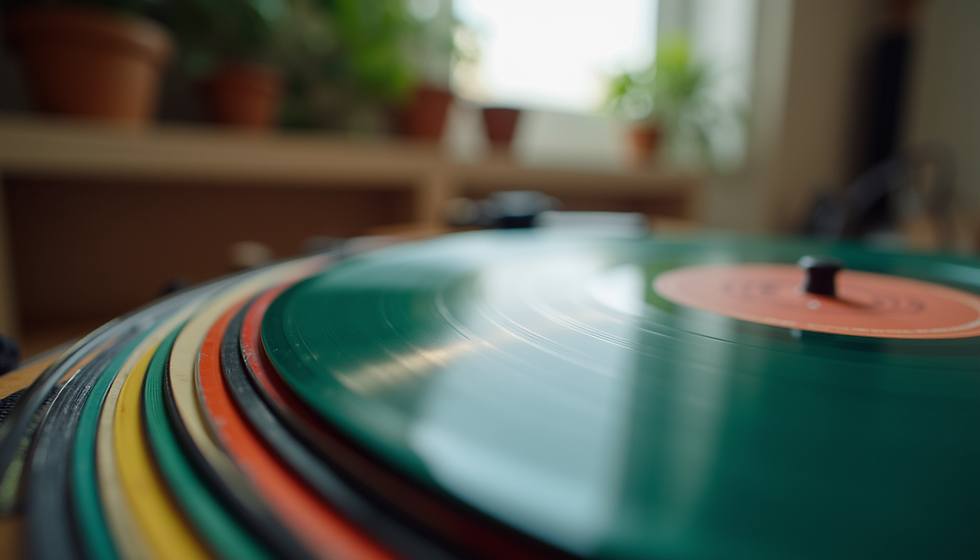How Vinyl Records Shaped Modern Music
- raygiguere
- Jul 15
- 4 min read
Vinyl records are more than just a medium for music; they are a cultural phenomenon that has shaped the landscape of modern music. While digital downloads and streaming services dominate the current music scene, the resurgence of vinyl in recent years has sparked new interest and appreciation for this classic format. This blog post will delve into how vinyl records have influenced music production, distribution, and the overall listening experience.
The Rise of Modern Vinyl
The allure of modern vinyl can be traced back to its superior sound quality compared to digital formats. Vinyl records offer a warmth and richness that is often missing in compressed audio files. Many audiophiles and casual listeners alike appreciate the depth of sound possible with a vinyl record, making it a compelling choice for listening experiences.

In the digital age, where convenience often trumps quality, the tactile nature of vinyl provides a refreshing change. The act of selecting a record, removing it from its sleeve, and placing it on a turntable creates a more engaged listening experience. Collectors and casual buyers alike find joy in the artwork, the weight of the vinyl, and the physical presence of records in their homes.
The revival of vinyl records began in the early 2000s and has continued to grow. According to the Recording Industry Association of America, vinyl sales have reached heights not seen since the 1980s. Sales of vinyl records in the United States have surpassed those of CDs in recent years, indicating a significant shift in how people prefer to consume music.
The Impact of Vinyl on Music Production
Vinyl records have also had a profound impact on music production. The medium imposes certain limitations that can actually enhance creativity in the studio. Artists and producers must consider factors like track length and fidelity, which can lead to more thoughtful arrangements and songwriting.
For instance, producing an album meant to be released on vinyl often requires tracks to be structured strategically. This may lead to more cohesive albums where each song flows into the next, as opposed to singles that can often dominate today’s music landscape. Artists like Adele and Jack White have embraced this, releasing albums that offer a full listening experience rather than merely scattering a few popular tracks.
In addition, the vinyl pressing process itself demands a different approach to sound engineering. Because vinyl is an analog format, the mastering process must ensure that the sound translates well when transferred to the physical medium. This often leads to recordings that feel more organic and rich, contributing to the timeless quality of records.
What Is a Reasonable Price for a Vinyl Record?
Pricing can vary significantly depending on several factors such as the artist, rarity, and condition of the record. Generally, new vinyl records range from $20 to $40, while used records can be found for as little as $5 or as much as several hundred dollars for rare editions.
When purchasing vinyl, consider the value of the album itself. Special editions, colored vinyl, or albums with unique packaging can be priced higher. Online platforms and local record stores, such as those specializing in vinyl records Winnipeg, often carry a diverse selection for every budget.
It’s essential to check the quality of used records before purchasing. Look for any visible scratches, warps, or significant blemishes that may affect playback. Many stores allow you to listen to used records before buying, providing an opportunity to assess quality firsthand. A well-maintained vinyl can enhance the listening experience, making it worth any extra cost.
The Vinyl Revival and Modern Artists
The vinyl revival has not only influenced consumers but also contemporary artists. Many musicians are now releasing their albums on vinyl to cater to the growing demand. This resurgence has allowed artists to connect with fans in new and meaningful ways.
Crowdfunding platforms have also played a role in this vinyl revival. Many artists are now funding their projects through sites like Kickstarter, which allows them to gauge interest and secure pre-orders for vinyl releases. This approach not only helps artists finance their projects but also builds a community around the music.
The resurgence of interest in vinyl has also prompted artists to create unique experiences related to their music. Special album releases, live performances, and exclusive merchandise packages have become increasingly common. This approach fosters a dedicated following and encourages fans to engage more deeply with the artist’s work.
Conclusion: The Future of Vinyl Records
The future of vinyl records seems bright as they continue to influence modern music and culture. While digital streaming remains the dominant format for music consumption, the love for vinyl persists, creating a unique niche in the music industry.
Aside from sound quality and nostalgia, vinyl records offer a certain aesthetic appeal that digital formats cannot replicate. The artwork and packaging are often as significant as the music itself, turning records into collectible items. As more musicians and fans embrace this format, the cycle of creativity and appreciation for vinyl will likely continue.
If you’re looking to dive into the world of vinyl, consider visiting local record stores or checking out online platforms. Whether you’re a seasoned collector or a newcomer, the world of vinyl offers a vast array of music waiting to be discovered.






Comments